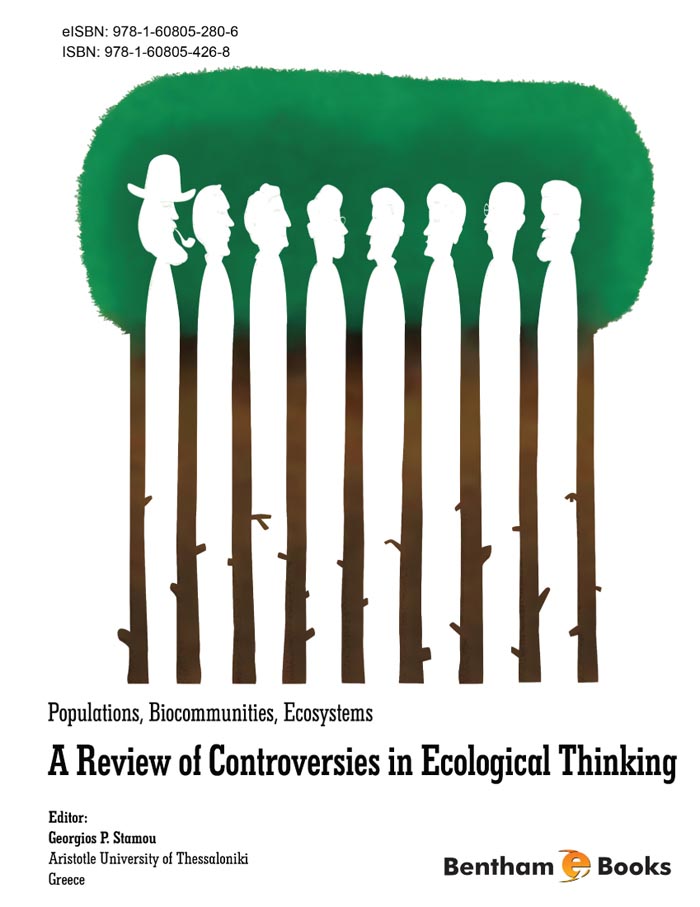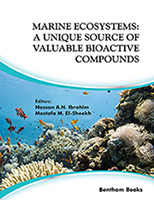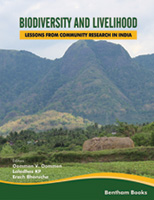In presenting ideas developed in four Ph.D. theses supervised by the editor, this eBook aspires to offer a broad historical and epistemological overview of various aspects relating to the evolution of ecological thinking during the last decades. Precisely, rather controversial issues tied up with different levels of ecological structures, from population to ecosystem are critically discussed, while the social correlates of ecological reasoning are also considered.
The first chapter presents epistemological issues that bring together the whole endeavor, while the next chapters are case studies tackling maters relating to a) the conditions defining the emergence of a new field within a pre-existing framework (life history strategies), b) long-lasting and rather futile controversies such as those concerning reductionism and holism (community ecology), c) the endeavor to revive a declined field (systems ecology), and d) the relations between scientific practice and society (the emergence of ideas relating to diversity).
Specifically, in the first chapter the author shows how critical realist aspects may condition sound ecological studies. He first argues that flourishing views relating to the social correlates of ecological investigation call upon the enrichment of ecological reasoning regarding biophysical phenomena with insights from social theory. Then, he contends that critical realism may fulfill this task by developing the idea that meanings relating to reality are continuously informed by reference to existing real objects and structures.
The author begins his endeavor to show how critical realism may achieve effective ecological explanation/interpretation by outlining a framework which combines aspects of althusserian epistemology with aspects of bhaskarian ontology. He firstly points out that critical realism is a materialist project in that it acknowledges the primacy of existence vis-à-vis the knowledge about existence. Then, following Bhaskar and Lawson the author describes the idea of a stratified real world comprising a deep layer of non observable causal mechanisms, which generate non-observable events at an intermediate layer, whereas empirical events are recorded only at the surface layer. He connects the explanatory task with the description of the deep generational mechanisms.
Secondly, the author describes an equally stratified process of knowledge production of althusserian origin. Developed upon realistic grounds, this perspective distinguishes between the raw material really existing out there and the raw material of the knowledge process. This latter is an already elaborated mental structure made of value/ideology-laden first ideas, previous knowledge, representations, pre-existing concepts and the like (termed Generality I) relevant to the raw material out there. Then, to draw out ideological loads rather abstract concepts (Generality II) are employed to finally construct a coherent mental structure named Theory or Generality III.
The next paragraphs of the paper are dedicated to concrete scientific practice. First, by illustrating how the biological worldview is expressed in the field of ecology the author stresses that any practice is integrated within general and partial theories. These latter describe one among the many worlds potentially stemming from the general theory. The stepwise factualization of theoretical considerations is achieved by means of a continuous back-forth movement between theories and experimental data through models at different levels of generality.
The last paragraphs of the first essay are dedicated to comparisons between critical realism perspectives and similar perspectives coming from different theoretical traditions such as positivism, pragmatism and hermeneutics. The author describes radical asymmetries between critical realism and the other perspectives, but he concludes that for enhancing its explanatory power critical realism may critically borrow instrumental items from pragmatism and hermeneutics.
The main line of reasoning in the Chapter 2 is that controversies within scientific fields are the force leading to progress. This thesis is exemplified by turning to the emergence and transformation of the field of life-history strategies within population ecology. The author brings forth the idea that the peculiarity of the field of life history strategies resides on the fact that, although it emerged within a reductionistic–oriented field, namely population ecology, by focusing on the relationships between organism and environment, as well as on the interaction between life-history traits, demographic parameters and the fitness of the organism, the field developed a theoretical core characterized by strong holistic elements. Moreover, the author asserts that the new worldview conforms to neodarwinian ideals since life histories and life history characteristics are continuously changing entities: the same species displays different life history characteristics in different environments, while life history features of an organism may change over time.
Initially, the author emphasizes that during the first phase of the field’s development the environment was not, in fact, embodied into methodological tools. Thus, important theoretical concepts, such as strategy, were not included in the theoretical tools of the field. Then he describes the development of the “r-K selection” model and outlines the methodological and epistemological ideas of R. H. MacArthur, the main advocate of the “r-K selection” model. He concludes that although offering a framework allowing for generalizations, the “r-K selection model” remained largely within the reductionistic scientific tradition. Moreover, alternative models taking into consideration population age structure and/or stochasticity, should be considered as complementary to the “r-K selection” tools as they actually contributing in enriching the theoretical content of the field.
Next the author discusses the development and establishment of habitat templets, which graphically depict the development of life-history strategies in specific environmental conditions and describe different fundamental mechanisms of causality. Then, the author shows how the adoption of such a synthetic-holistic point of view in conjunction with focus on problems such as the complexity of relationships between organisms and environment, or the nature of the trade-offs between life-history characteristics, resulted in the study of phenomena not previously considered.
The last section of the chapter deals with the implications to the wider theoretical framework of ecology. It is argued that within the worldview factualised by the habitat templets, concepts such as heterogeneity, favorability and plurality became important, emphasis put on the relationship between organisms and environment, while favored the handling of adaptive characteristics within a holistic context. The author finally concludes that the development of the whole theoretical framework renders the dispute holism - reductionism rather irrelevant in respect to ecological scientific practice.
In Chapter 3 the author addresses the old but still intriguing holism/reductionism debate in ecology to finally suggest that it is no more than a trivial dichotomy; a common fate for most dualisms. Dealing simultaneously with complex socio-scientific issues, ecology is often perceived by scientists, educators and the media as an alternative science promoting holism and systemic thinking. Despite this view, partly dictated by an overwhelming social attention and success, not all ecologists see their endeavour as a holistic exemplar. The author, however, does not accept the straightforward distinction between a population-reductionistic camp and its ecosystemic-holistic rival either. Hence, while attempting to answer the question: Is ecology a holistic science after all, she gradually reconstructs the various arguments to advocate a pluralistic conception of the science of ecology.
More specifically, she first turns to the formative years of the discipline to offer a concise history of the debate. She describes how ecologists attempted to bring together their ontological and methodological commitments to form coherent theoretical frameworks while engaging one way or another in the holism/reductionism discussion. The author especially stresses the fact that even during these first years ecology did not map comfortably onto the dualism. Indeed, the writings of a number of early population ecologists could hardly be seen as a promoting a reductionistic perception of ecological entities or processes.
The author further elaborates on the subject by focusing on the ontological and methodological assumptions of both perspectives. While accepting that the polemical story between a reductionistic research tradition, which assigns ontological primacy to parts and proceeds by always looking down, and a holistic research tradition associated with the study of integrated wholes and their emergent properties has some elements of truth, the author explores their points of convergence. Thus, she regrets to agree with other critics that ecosystem ecology proved ill-equipped to face the challenge of developing a proper holistic methodology. Furthermore, she asserts that a hybrid mechanistic-organismic view of nature, an adherence to an essentially fundamental level of investigation and physics-envy marked both undertakings.
The chapter closes with an exploration of the dialectical approach advanced by Richard Levins and Richard Lewontin as a possible remedy to dualistic thinking. Their vision was bold and provocative. As this chapter demonstrates the dialectical approach offered a synthetic alternative that could be characterized as pragmatic pluralism. While most ecologists end up using a variety of methodologies to deal with the intellectual challenges posed by complex systems, Levins and Lewontins’ thoughtful analysis resists mere eclecticism. The author hopes that their view will contribute to raising awareness that conscious scientific practice demands considering ontological and methodological issues simultaneously.
Chapter 4 deals with systems ecology in the style of Howard Odum, which was the prevailing ecological paradigm from mid-1950s to early-1970s and declined afterwards. However, the author contends, the advocates of systems ecology continued to elaborate the old ‘anomalies’ and defend field’s building blocks against critics. These efforts attain full growth in the 90’s by a series of paper signed by three important system ecologists, Bernard Patten, Sven Eric Jørgensen and Milan Straškraba, in which they declare their intention not only to just repeat or review what is already known but also to introduce some new perspectives on ecosystems. Apparently their efforts are considered significant from an epistemological point of view: stressing that a ‘new systems ecology’ may be proved beneficial for both ecological science and society, they implicitly attempt to bring systems ecology to the fore and make it flourish again.
The work hypothesis of this essay is defined as follows: the efforts of Patten and coworkers will be successful if the new system ecology overcomes the problems that led the old systems ecology to decline. These problems refer to both the interior of the field and the relations of the field with the social domain. The author assumes that success is possible if the new field will be able to face both the past internal anomalies or riddles and the incompatibilities with social needs and ideas. Such an assumption is meaningful within a specific frame for seeing science. Following Baltas’ interpretation of Althusserian epistemology, the author argues that although the development of a scientific field is carried out perpetually and exclusively through its constitutive elements and their interrelations, it is related to the social experience of scientists and the ideological way they come to cognitive terms with the empirical world.
Content analysis of this series of papers by Patten and coworkers shows that they borrow rather spontaneously conceptual resources from the nowadays-prevailing postmodern worldview. As a matter of fact, the innovations introduced are homomorchical to ideas stemming from contemporary social network theories, a representative of which is Actor-Network Theory (ANT). The author offers a brief sketch of these homomorphisms and argues that they may help Patten and coworkers to make their research program progressive. More specifically, the innovations introduced make it possible for Patten and coworkers to step up with the contemporary worldview and solve the old worrying problems such as those related to holism i.e. the failure of systems ecologists’ a) to define ecosystem boundaries b) to treat the ecosystem as a biological and not as a physicochemical system and cope with biological realism and c) to make their ecosystem perspective consistent with constitutional thesis of modern holism calling for a pluralistic ontology.
Nevertheless, the author holds that Patten and coworkers avoid questioning the latent ideological assumptions of the old field and prevent themselves from dislocating the former structure. Ideological assumptions based on scientific romanticism (a specific kind of holistic viewing) and the technocratic worldview (a specific way of seeing social organization) continue to influence the interpretation of the building blocks of systems ecology and thus the innovations are not properly re-contextualized. As a result their beneficial potential is inhibited and the old problems such as those associated with holism remain unsolved within a framework that also fails to harmonize itself with the contemporary social ideas and needs.
In Chapter 5, the well-known ambiguity of the concept of diversity is interpreted as the result of hidden, socially originating, ideological representations within the scientific fields of ecology. In this spirit, the theoretical and methodological background of ecology in the early 1940’s is investigated and the author concludes that ecology was, even then, still influenced by organicism, according to which biological communities were considered as stable, discernible, harmonically and hierarchically organized unities of members. Their internal order was expressed by new statistical models which tried to provide a regular, repeatable pattern for species’ composition. In this context, diversity firstly appeared as a statistical constant within the equations of species-individuals curves, expressing the equitability in which individuals are distributed to different species. However, these equations were “automatically” reversed and, hence, the measurement of diversity became the central question. Accordingly, ecologists employed new methods and concepts from Statistics, Systematics and Information Theory in order to find appropriate diversity indices. The author argues that the emergence of diversity measures through a reification process was motivated by hidden ideological representations.
In the next paragraphs, the author examines the relation of diversity to other important ecosystem’s properties, such as stability, productivity and efficiency. He argues that beyond all the contradictory discussions, ecologists tried to establish a positive correlation between diversity and stability, due to an external, social pressure for appropriate criteria for ecosystem management, to deal with the arising ecological crisis. Nevertheless, through this socially motivated correlation, the meaning of ecological stability is re-determined, acquiring a cybernetic, quantified definition; the lack of fluctuation. Similar arguments are proposed for the relation between diversity and productivity or efficiency. The author arrives at the conclusion that under the domination of diversity, a network of correlated, quantified, measurable and manageable ecosystemic concepts was emerging from the old fields of community and ecosystems ecology, leading to the unifying attempts of the late 1960’s. Thus, diversity arises as the nodal point of its field, that is the concept that transforms and determines the meaning of all the others, due to its socially originating power.
Finally, the author argues that the crucial point in all these processes is the dominant social demands for new guidelines of environmental management. New disciplines, like human ecology, environmental or ecological engineering, arouse to merge socioeconomic with ecological concepts. In this context, ecology, still based on the organismic tradition and the cybernetic presuppositions, was getting even more distanced from evolutionary theory.
The ideas presented in this eBook owe a lot to the many colleagues who participated in the examination of the Ph. D. dissertations. Among them we are indebted to Professors K. Kribas, L. Louloudis, A. Mpaltas, G. Fourtounis, J. Pantis, Z. Scouras and G. Goundaroulis for helpful criticism, which helped to further evolve our insights. Various ideas included in this eBook have been published in scientific journals, thus we acknowledge the help offered by unknown referees.
Prof. Georgios P. Stamou
University of Thessaloniki
Thessaloniki
Greece




